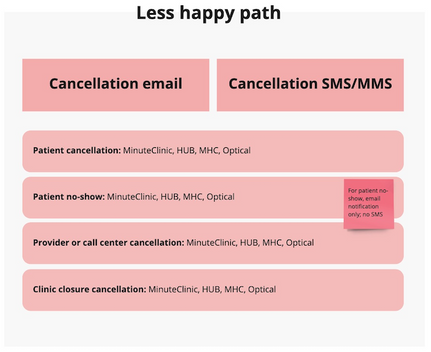CVS Health
Designing dynamic appointment notifications & strategy for 135+ visit types
The problem
There were longstanding notifications-related painpoints that were negatively impacting the patient experience at MinuteClinic. Additionally, MinuteClinic as a business was moving towards 100% scheduled appointments (versus a walk-in model), placing even greater importance on timely, informative notifications. Lastly, the pandemic arrived — making a shared public kiosk at clinics a pretty unappealing device to engage with. All patient engagement needed to go mobile, with email & SMS notifications being the primary channels supporting a better experience.
"CVS cancelled my covid-19 testing today. Why??"
"I need confirmation and instructions!"
Final designs (process below)
Final designs often appear simple, but the process is not. How did we get here?
FIRST
Understanding the existing notifications ecosystem
There was no existing documentation for notifications: what was in production, how/when they were triggered, where they came from (backend) — let alone any elegant bird's eye view of the end-to-end experience or context within the service model. I set out to investigate these questions and developed the following high-level artifacts to guide me through next steps of strategy and design.
THEN
Aggregating patient & clinician painpoints (two important perspectives)
Leveraging patient feedback from OpinionLab, our Voice of Customer team, and clinician testimonies, I collected our top painpoints, including but not limited to:
-
Lost confirmation codes
-
Missing functionality (add to calendar)
-
Inadequate instructions
-
Lack of customization
It is important to note that many of these painpoints not only impacted our patients, but our clinicians as well. For example, when patients couldn't find their confirmation codes to check-in, they would knock on the clinician's door for help, interrupting another ongoing appointment in the process. In other cases, our inadequate communications would cause patients to show up ill-prepared for their appointments (missing paperwork, not having fasted prior).

NEXT
Developing dynamic content & special visit instructions to customize notifications
Something understood from the onset of this work was that our one-size-fits-all approach to notifications was not sufficient for the complexity and range of our services. The ability to customize our communication, based on why the patient was coming in, was essential to providing a good experience. While I developed the anatomy and framework for these new notifications, my content strategist tackled the writing (which was a HUGE undertaking). After analyzing and boiling down 135+ visit types (across three business units with different check-in procedures), the following dynamic content/special visit instructions were roughly determined. All of which went through clinical and legal approval ;).

AND
Wireframing, iterating & documenting...REPEAT
You cannot design notifications in isolation from one another or the end-to-end experience. A lot of thought & iteration went into not only the design for the modular body of a single email, but how the set of email & SMS notifications would work together. Throughout the design process, we sought to strike the right balance of clear & concise, but informative communication. Considering the length and complexity of some visit types, we advocated to migrate from SMS to MMS messaging for a more elegant experience that would allow us to adequately message the patient, while giving us flexibility to maintain a strong level of readability / digestibility.
_%20dynamic%20content%20%26%20notifications%20-%20SMS%20flowchart.jpg)
Final thoughts...
This was a far-reaching project that required a lot of systems thinking. It was further complicated by a lot of enablement work required from product. Designs were delivered that were feasible today, but it was important to also look towards the future and demonstrate how we would like things to work with smarter, more connected backend systems.
As always, there was a lot we expected to learn once released into the wild. Tracking user engagement (particularly around links & actions), and observing service delivery improvements in the clinics (hopefully), would be essential to our continued improvement!



































